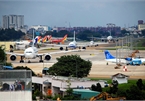 |
The National Assembly (NA) has issued a resolution on a feasibility study for the first phase of the Long Thanh International Airport project, in which the government will offer no loan guarantee and the selected investor will instead have to manage the fund itself. The move is seen as a blow for interested lenders, often requiring such a government guarantee for initiatives of this magnitude.
Vietnam has recently been working with Sweden on the possibility of mobilising a $1 billion loan from the Scandinavian country in order to invest in Long Thanh International, along with air traffic management.
Like other groups, the Swedish Export Credit Corporation (SEK) is concerned about the possible risk without a government loan guarantee. Per Åkerlind, deputy CEO and head of Strategic Partnerships and Relations at SEK, said that the Ministry of Finance guarantee is the most important factor in reaching the $1 billion loan amount.
As a result of the move, the International Financial Corporation, despite meeting with Deputy Prime Minister Vuong Dinh Hue last month to demonstrate its attentiveness to the airport project, may also have second thoughts.
A similar situation is forecast for Asian Development Bank, Japan International Cooperation Agency, HSBC Vietnam, and Mizuho Bank Ltd., which are among lenders that have been active in transport projects in Vietnam.
The scenario is expected to push Airports Corporation of Vietnam (ACV), which had earlier been proposed by the government as chosen investor in its feasibility study report submitted to the NA’s November session, to pivot to domestic lenders if selected.
If so, ACV will have to arrange nearly $5 billion for the first phase of the project, which consists of annual capacity of 25 million passengers and 1.2 million tonnes of cargo yearly.
A corporation official said that even with no government guarantee, ACV will raise funding to ensure project development on schedule. His confidence is based on the high growth potential of the burgeoning aviation market in Vietnam, in which passengers and cargo are forecast to increase around 10 per cent on-year.
In addition, ACV is performing well, with revenues and profit aiming to rise 7 and 9 per cent respectively in 2019. In the period 2020-2025, it expects to accumulate around VND12.34 trillion ($536.5 million), thus increasing its possible financial capacity in Long Thanh airport to $1.94 billion, or nearly 40 per cent of the first phase’s total investment.
The airport giant already operates 22 airports, a big advantage illustrating that it could also manage investment capital for the Long Thanh airport. Despite these advantages, there are doubts over ACV’s funding mobilisation for the airport. Le Duc Khanh, director of market strategy department at PetroVietnam Securities told VIR that while ACV has strong financial capacity, $5 billion is a large amount at a time when the corporation is in need of money to invest in development projects. “The investment may cause risks to its operation, with the high possibility of facing sluggishness in development, and a rise in capital, regardless of possible problems about control of investment activity and return of investment.”
Currently, not all the 22 airports it manages are performing well. Six of the airports – including Noi Bai, Tan Son Nhat, and Danang – are generating profit, while the others are suffering losses. In particular the Vinh, Tuy Hoa, and Can Tho airports incur an annual loss of VND80-90 billion ($3.48-$3.91 million), while the threshold for some others is around VND40-60 billion ($1.74-$2.6 million).
Khanh’s thoughts resonate with Nguyen Tung Anh, analyst from KB Vietnam Securities, who added that there are some risks for ACV in funding mobilisation. “The highest risk is the possibility of facing an increase in capital. At present, the investment rate of the Long Thanh project is $4 billion higher than others of the same scale worldwide, for example Istanbul Airport,” Anh said. “Thus, any rise in investment will affect project efficiency. Domestic and international co-operation with partners is an option for ACV to ease the financial burden.”
A lot of international businesses have showed interest in the Long Thanh scheme. Under the NA resolution, the first phase will include a runway, a passenger terminal, and sub categories including aprons, an air traffic control tower, parking lots, air catering, aircraft maintenance, and a fuel supply and waste recycling station. According to the Ministry of Transport, international ventures are able to join services, maintenance and repair, catering services, hangars, and airport hotels in the Long Thanh project.
Naturally, US aircraft giant Boeing does not want to miss out. Executive vice president Kevin McAllister, after signing billions of US dollars worth of aircraft orders with Vietnamese airlines, disclosed that it is eyeing collaboration with the country not only in selling planes, but also in technical, maintenance, and airport infrastructure management.
Also recently, Swedish giants such as Ulf Rudebark, SEK, SAAB, Ericsson, Asix Communications, and Volvo have shown interest in both Long Thanh and the Vietnamese aviation sector as a whole.
Previously, many others from South Korea, Japan, China, and the US are queuing up, including Lotte Engineering and Construction Co., Ltd, and Japan’s Taisei Corporation. VIR
Bich Thuy

US$478-million Tan Son Nhat airport terminal project submitted to PM
A VND10.99-trillion (USD478 million) project to build Terminal 3 at Tan Son Nhat International Airport in HCM City has been submitted to Prime Minister Nguyen Xuan Phuc for consideration.

Investors willing to spend billions of USD to build airports in Vietnam
The door has still not opened widely to private investors who want to develop airports.
 International financiers may have no room to join Long Thanh International Airport project, with the lack of a government loan guarantee creating a major obstacle for would-be investor Airports Corporation of Vietnam to ensure bankability.
International financiers may have no room to join Long Thanh International Airport project, with the lack of a government loan guarantee creating a major obstacle for would-be investor Airports Corporation of Vietnam to ensure bankability.